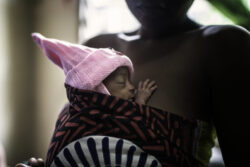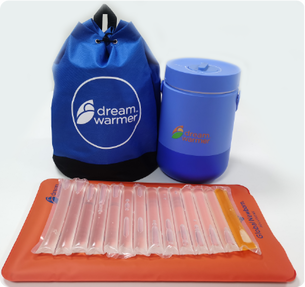Keeping Newborns Warm: How the Dream Warmer Supplements Kangaroo Mother Care
The Dream Warmer is an affordable and reusable non-electric infant warmer that supports skin-to-skin (STS), also known as Kangaroo Mother Care (KMC). This unique plastic mattress, filled with phase change wax, maintains skin temperature for up to six hours after activation with hot water. It was one of 58 solutions presented at the IMNHC 2023 Technical Marketplace, which showcased promising maternal and newborn health interventions and innovations in an engaging and interactive format. The various exhibits and demonstrations provided an opportunity for conference attendees to learn and be inspired, while serving as an opportunity for presenters to share, collaborate, and benefit from collective thinking.

A newborn baby is particularly prone to rapid heat loss and subsequent hypothermia. Fetuses are in the thermo- neutral environment of the uterus before birth, requiring no energy be exerted to maintain a normal body temperature. Babies born early or small will cool towards the temperature of their environment unless provided with an external heat source to re-establish this thermo-neutral environment. If this external heat chain is broken, babies may develop hypothermia which increases mortality risk. For survivors they must steal calories intended for somatic growth and spend them on thermoregulation. This causes stunted brain growth thereby impairing neurocognitive outcome and perpetuating the cycle of poverty. The smaller and more premature the baby, the greater the risk of hypothermia and growth impairment. Thus, a continuous external heat source is necessary until the newborn has the approaches their due date. Maintaining the appropriate temperature of a newborn baby, referred to as thermoregulation, is essential to prevent newborn mortality and morbidity.
In the recent kangaroo mother care (KMC) Global Position Paper, the World Health Organization (WHO) recommends immediate KMC (iKMC) as routine care for newborns to prevent hypothermia, particularly for preterm or LBW infants. There may, however, be certain situations in which a baby is not able to receive iKMC, such as unavailability of the mother or alternate caregiver or a baby experiencing apnea or severe respiratory distress. These situations can be particularly challenging in low- and middle-income countries (LMICs) where radiant heaters and incubators are not available, not functioning, or electricity and resources are not available to power these kinds of devices.
In this Q&A with Dr. Anne Hansen, Associate Professor of Pediatrics at Harvard Medical School and a leading expert in newborn medicine, we delve into the innovative solution of the Dream Warmer and how it can meet this critical gap of providing thermoregulation for newborns when iKMC is not an option or when KMC does not provide sufficient heat to achieve euthermia. Dr. Hansen shares insights into the Dream Warmer’s development, research supporting its efficacy, and its potential to address the complexities of neonatal hypothermia in resource-limited settings.
AlignMNH: Please give a brief background for readers who have not heard of the Dream Warmer.
Anne Hansen: The Dream Warmer is a plastic mattress filled with phase change wax that is designed to stay exactly at skin temperature for approximately 6 hours after it is melted with hot water. The Dream Warmer kit includes the warming mattress, an insulating sleeve, a thermos for heating the mattress, and a backpack for transporting and storing all the materials. It can be used as an additional source of heat when KMC is not sufficient or as an independent source of external heat when KMC is not available. It can also be used in the delivery room for neonatal resuscitation, to keep infants warm when they have medical needs that require assessment or treatment that is not compatible with KMC, during intra or inter-facility transport, and in the home setting. It has been studied extensively with over one thousand uses, demonstrating high rates of safety, efficacy, and usability.

What makes the Dream Warmer unique as compared to other newborn warming techniques?
Unlike other warmers, the Dream Warmer has no attached fabric so that it can be cleaned and reused even in settings without diapers or washing machines. The mattress is easy to prepare, use, clean and maintain; simple instructions are provided on the insulating sleeve to ensure comprehension even by those with low literacy skills. It allows medical staff and parents easy access to the baby.
It can be used by anyone, anywhere.
What research has informed the development and continued to strengthen the use case for the Dream Warmer?
The Dream Warmer has been studied in two pilot studies (published in Public Health Action, 2018 and Global Pediatric Health, 2019) and a large, stepped wedge cluster randomized trial in Rwanda, as well as implementation science studies in Malawi, Rwanda (submitted for publication), and Chiapas, Mexico (data currently being analyzed).
Both in the strict study setting and under real world conditions, the Warmer consistently has about a 90% combined efficacy rate of preventing or treating hypothermia with no adverse events or instances of it being prepared, used or cleaned incorrectly. In qualitative research, both health care providers and parents praise the Warmer for its simplicity in complementing KMC.
Are there any limitations or challenges associated with using the Dream Warmer?
The Dream Warmer is intuitive and requires only a brief training – it is critical to explain use of the thermal indicator that shows when the Warmer has cooled adequately to begin use. The only challenge is health care providers remembering to prepare the Warmer in advance of need. It takes only a few minutes of hands-on time to prepare, but if left until it is needed, the total waiting time can be up to 45 minutes.
What have been the key progress areas for the Dream Warmer in the last year since IMNHC?

The team has designed and conducted implementation science studies of the Dream Warmer in Malawi, Rwanda, and Chiapas, Mexico. Multiple device distribution companies were contracted to make the Dream Warmer available around the globe. The US FDA classified the Dream Warmer as a “product,” rather than a “device” and therefore outside of their purview. The Dream Warmer was analyzed by TUV, a third-party safety verification organization for products, who gave it a full report of safety. The Dream Warmer is awaiting the final signatsure of approval from the Rwandan FDA. The Dream Warmer was presented at the Big Steps Little Feet conference in Tanzania and to the Ministries of Health in Lesotho, Malawi, and Rwanda where it was enthusiastically received as a thermoregulatory option.
After completing the Design For Manufacturing process, the Dream Warmer is now professionally manufactured and commercially available through Maternova, IMRES, and VNG. The Dream Warmer is also included in the NEST360 Target Product Profiles. 100 Dream Warmers were donated to Ukraine and are inquiring regarding donations to Gaza. Inquiries have been received from sites around the world including Tanzania, Burundi, Ethiopia, Uganda, the Philippines, Dominican Republic, and Guatemala.
What are the next steps for expanding use of the Dream Warmer?
A new, related product, called an e-dream warmer is currently being developed. This is an electric heating pad that remains at skin temperature with a battery for when the electricity is out or for transport. Two short educational videos with footage showing the Dream Warmer are being filmed in a district hospital in Rwanda. One video is for health care providers and one for parents; in them, the importance of a continuous thermos – neutral environment, demonstrate the provision of high quality KMC, and clarify the role of a heat producing wrap such as the Dream Warmer when KMC is unavailable or insufficient.
Our larger expansion plan for the Dream Warmer includes partnering with ministries of health and individual health care providers to the bring the Warmer to hospitals and health centers in low resource settings around the globe. Because hypothermia is estimated to contribute to 40% of neonatal deaths in these settings, addressing this preventable condition is a key strategy to achieve the neonatal 2030 Sustainable Development Goal, namely < 12 neonatal deaths/1000 live births. Please contact us through our website: globalnewborn.org if you are interested in being one of those partners.
Dr. Anne Hansen received her MD from Harvard Medical School and her MPH from the Harvard School of Public Health. She completed her pediatric residency and neonatal fellowship at Boston Children’s Hospital (BCH). She is an Associate Professor of Pediatrics at Harvard Medical School, the Associate Chief of the Division of Newborn Medicine at BCH, and holds the Barry Family Research Chair in Newborn Medicine.
Dr. Hansen has been the medical director of the BCH Neonatal Intensive Care Unit since 2003 where she also conducts research in medical device development and global health. She was a key contributor to the Rwandan National Neonatal Protocols and is the editor of multiple books including The Manual Of Neonatal Care and The Manual of Surgical Neonatal Intensive Care. She has authored over 50 original research articles and over 50 chapters.
Dr. Hansen is one of the inventors of the Dream Warmer and the founder and CEO of Global Newborn Solutions, the non-profit that manufactures and distributes it. She has been the principal investigator for all publications pertaining to the Dream Warmer.